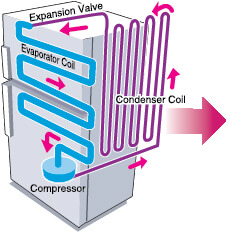Perhaps, old is not always gold!!
Most refrigerators, especially freezers are energy guzzlers. You may not realise it, but they consume 30 - 50% units of a normal household. But most refrigerators are underutilised. They don’t contain more than
This often fills only 10% of the capacity!!

Refrigerators use mechanical force to remove heat from food items. This heat is absorbed by a liquid known as a refrigerant. The refrigerant circulates in a closed loop. It absorbs heat and becomes a gas. (A portion of the heat dissipates through a condenser coil). Then the gas is compressed by a compressor to a high pressure gas, causing it to become a hot gas. The absorbed heat dissipates to the environment through condenser coils. Once the heat dissipates (removed), the gas becomes a liquid-gas mixture and recirculates through the network of pipes located inside the freezer and refrigerator. The cycle is repeated as long as the refrigerator remains on.
World over, the trend is shifting towards natural refrigerants. They are mostly hydro carbons and some advance companies have used CO2 as a refrigerant on a pilot scale. These new refrigerants such as R 600 are Ozone Depleting Substances (ODS) and in most cases, have lower Global Warming Potential (GWP). Since most hydro carbons are ready to combust substances, care must be taken to contain those without exposing to naked flames.
Modern refrigerators, especially freezers use about 1/10 of electricity used by refrigerators built 20 years ago.
So, if you have an old, old refrigerator, buy a new one. You will be saving both money and energy.
Be mindful of your actions
Choose the right size
The bigger the refrigerator capacity, the more energy it consumes.
A 190 litre refrigerator would be sufficient for a family of five.
Mind the door
Open doors result in a drop of 10 - 20oC
Don’t stand with the door opened while you drink water.
Use storage space wisely
It is always better to buy good air tight containers which into the storage space of your refrigerator. They should be placed in, even when they are empty. A fully packed refrigerator has less air space, therefore, less cold air will leak out when the door is opened.
Tidy up
Store items in order. Defrosting items on the top shelf, cooked meals, fruits next, and vegetables in the bottom-most drawer. A tidy refrigerator is almost easy to search and access. Make it a habit to rid the refrigerator of unwanted items, at least once in a fortnight or preferably weekly.
Use baskets or containers
Vegetables, fruits…etc. can be stored according to your preference or day’s need in containers or baskets. It’s easy to pick the right container at the right time, rather than picking something from here and something from there. Store food in closed air-tight containers, if not the air in the refrigerator will absorb the moisture from food, causing it to lose its freshness.
Store liquids in closed vessels
Uncovered food, especially liquids release moisture into the refrigerator, making the compressor work harder.
Don’t store hot food
Cool them down to room temperature before putting them in. Hotter the food, the more heat the refrigerator has to remove.
Put back cold food soon after use
Cool food out of the refrigerator makes them gain heat. It is hard work for the compressor to cool them all over again.
Defrosting and thawing
Move frozen items from the freezer to the main compartment of the refrigerator. The food items will be automatically defrosted., ready for use in 10 - 12 hours. Thawing food will absorb heat from other items in the main storage area, relieving some hard work for the refrigerator. Less food in the freezer is less work for the compressor.Defrost the refrigerator when it develops an ice layer, one-centimeter thick.
Mind the beading
Ensure door seals are clean and closed properly. Rapid ice build-ups are indicative of poor sealing. Ensure that the polymer sealing gasket along the border of the door is firm. To test this, place a paper or a twenty rupee note between the door gasket and the fridge and close the door. Try to remove the note, if you feel the tension and if you fear that the note might tear off, then your gasket is in good condition. If the note comes out easily, then it is indicative of a leakage.
Ensure proper ventilation
Ensure proper ventilation around the condenser coils at the back of the refrigerator. Refrigerators with no visible coils at the back, need ventilation around both sides and the back.
Proper placement
Place refrigerators away from direct sunlight / hot surfaces and points of heat generation such as stoves and kettles.
Keep the coils clean
Dust build-up on condenser coils make refrigerators work harder. Make it a habit to clean these along with regular cleaning of the interior.
Right settings
If items that require deep freezing, (ex: ice cream, meat, fish…etc.) are absent from the refrigerator, lower the settings to a bare minimum. Maintain settings at 40% level (between 2 and 3 in a scale from 1 to 5), when deep frozen items are stored.
When away for days, you can either shut down the refrigerator, or adjust the settings to a minimum. This will maintain the internal temperature and the compressor won’t get activated for defrosting.
Discard junk
Store only what’s really wanted. A refrigerator is not the best place to store sweets and dry fish. Use other storage methods for such items.